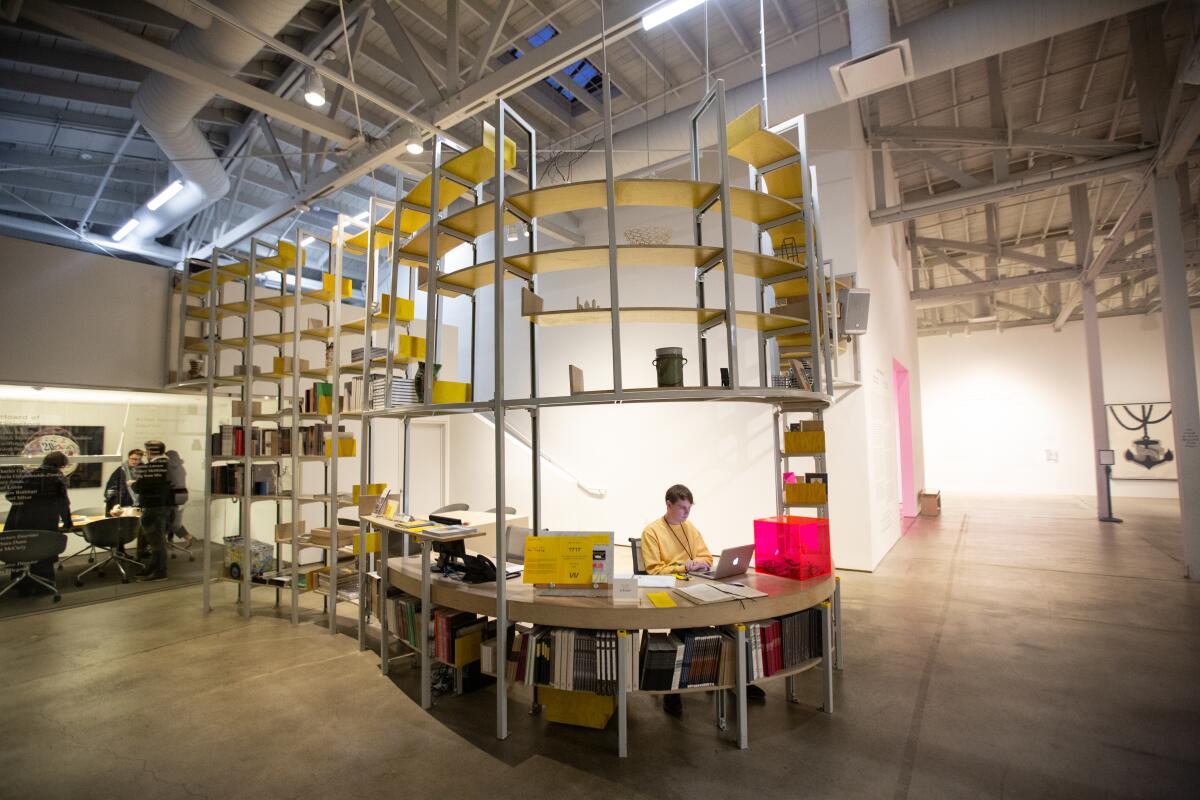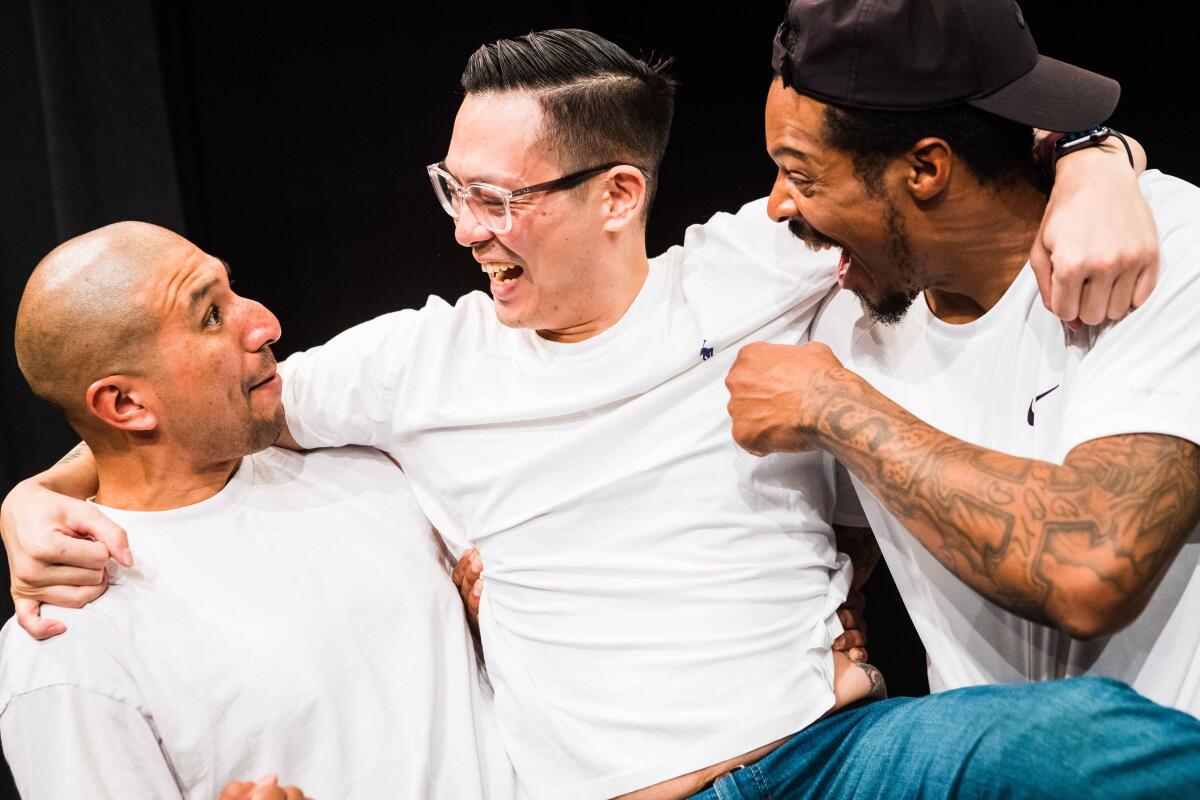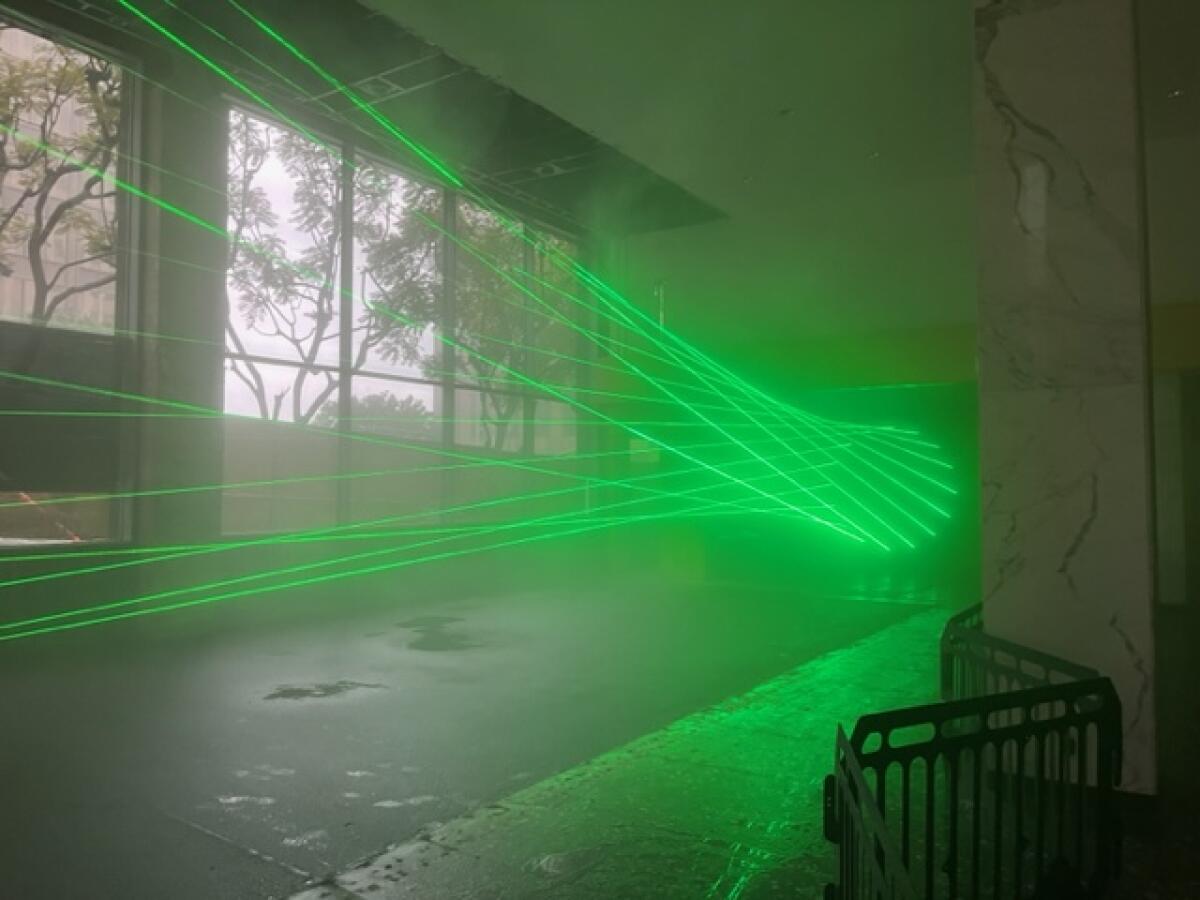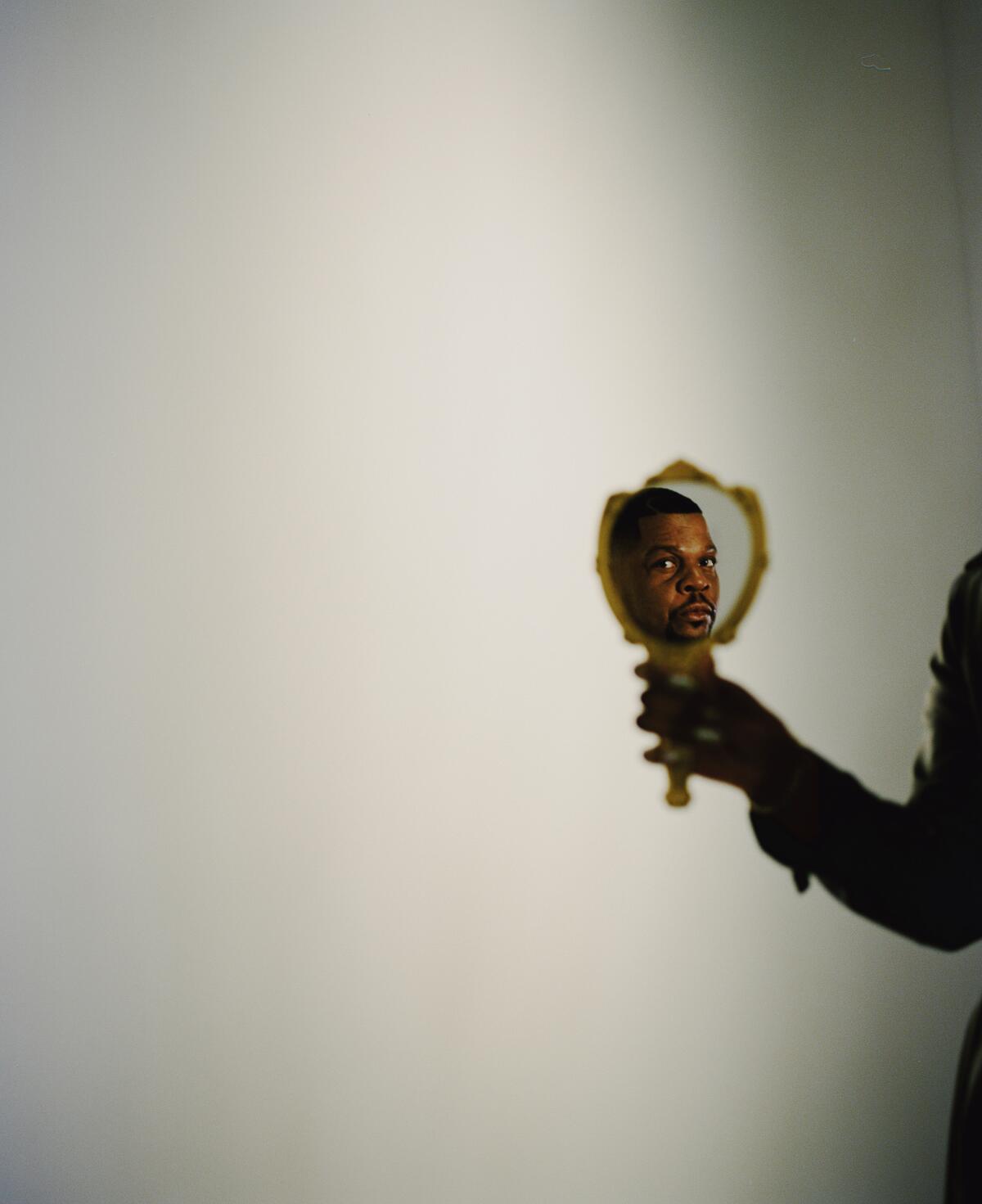How a coalition founded during the pandemic is helping small L.A. art organizations thrive

- Share via
The Times’ food team has an essential guide to dining in and around L.A.’s key arts institutions. I’m Carolina A. Miranda, art and design columnist at the Los Angeles Times, and I’d love it if all museum eateries everywhere could have at least one $10 sandwich on their menu because who is spending $45 on lunch? Now, here’s the week’s essential arts news and surreal variety shows:
Mutual support
It began as a way to contend with the challenges wrought by the pandemic.
As government-mandated shutdowns went into effect in the spring of 2020, leaders of small visual arts organizations in Los Angeles began to lay out phone calls to check in on their colleagues in the field. Those calls “morphed into a weekly Zoom meeting,” says Anne Ellegood, executive director of the Institute of Contemporary Art Los Angeles. “Then it started to develop into conversations of how we would work together.”
Those informal sessions led to the establishment of the Los Angeles Visual Arts Coalition, known as LAVA, a network of almost three dozen small- to mid-sized arts organizations that rallied in support of one another at a time when institutions everywhere were grappling with remote work, social distancing and the bureaucratic mire of PPP loans. This included spaces such as Crenshaw Dairy Mart, Clockshop, the MAK Center, Los Angeles Contemporary Exhibitions, the Mistake Room and Self-Help Graphics.

One of their earliest initiatives was to create a shared system of fundraising. This allowed for strength in numbers. It also allowed small arts groups without well-greased fundraising apparatuses to benefit from the resources and knowledge of larger arts institutions.
Three years later, LAVA has reached a milestone: The group — which operates as a nonhierarchical coalition — announced this week that, thanks to catalyzing grants from the Andrew W. Mellon Foundation and the Teiger Foundation, it had raised $2,660,000 in support of its aims. Now LAVA is dispensing $50,000 in unrestricted grants to each organization within the group. Within the larger institutions in the coalition, such as the ICA LA, which has an operating budget of $3 million to $3.5 million per year, the funds will help support a range of budgetary needs. For the smaller organizations in the group, however, many of which operate on budgets of $1 million (or far less), the grants have the potential to be transformative.
“For certain organizations, it may mean a staffer,” says Ellegood, who has been involved in the group’s fundraising committee. “Or maybe they’re going to fix an HVAC system that’s been broken. That’s something we’ve been advocating for — people need unrestricted giving.”
Yoon Ju Ellie Lee, who serves as director of Equitable Vitrines and the Korean arts group GYOPO, reports that the organizations she leads will be using their grants to hire staffers — a first for both. “Small groups like ours,” she said in a statement, “struggle with the ability to employ staff due to the scarcity of funding opportunities for core operating support.”
Make the most of L.A.
Get our guide to events and happenings in the SoCal arts scene. In your inbox every Monday and Friday morning.
You may occasionally receive promotional content from the Los Angeles Times.
Ellegood says the group fundraising model offered an intriguing option for funders. “Funders could consider a different approach to having impact,” she says. “You could support all of us, not just pick and choose.”
It also allowed small nonprofits to share resources that would have otherwise been prohibitive. This includes professional development workshops that allow members to sharpen their fundraising abilities or refine their mission statements. “Individually, we can’t hire these consultants,” she says. “But we can bring them on all collectively.”
The monies raised will also allow LAVA to hire its own staffer — since the coalition isn’t done fundraising yet. In addition to advocacy, financial support and development, Ellegood says the group has set its sights on raising enough funds to help all of the member groups cover health insurance for their workers. “We know how important this is,” she says. “We live in a time of pandemic and that’s not going to go away.”

LAVA is not currently an independent 501(c)3. (Member organization, Fulcrum Arts, led by Robert Takahashi Crouch, is serving as the group’s fiscal sponsor.) The concept for the time being, says Ellegood, is to remain flexible and reevaluate the coalition’s needs on an annual basis. For now the focus is on infrastructural needs that often get overlooked in the course of much arts fundraising. “Of course we need money for exhibitions,” says Ellegood. “But make it unrestricted and it could be that half goes to the show and half goes to payroll.”
It’s a small shift — but one that could ultimately make for far more resilient arts organizations.
On and off the stage
Lucas Hnath‘s “eerily gripping” play “The Thin Place” is receiving its California premiere in a “sensationally acted” production by Echo Theatre Co. The plot revolves around a woman who mysteriously vanishes and the daughter who is attempting to connect with her dead grandmother in supernatural ways. “Moving effortlessly between narration and dramatization,” writes Times theater critic Charles McNulty, “The Thin Place” mixes “the quotidian with the uncanny to stylish effect.”

McNulty also reviews the revised version of Anna Deavere Smith’s “Twilight: Los Angeles, 1992,” directed by Gregg T. Daniel, on view at the Mark Taper Forum, where it premiered three decades ago. “I was quite excited about the prospect of seeing ‘Twilight’ performed by other talents,” writes McNulty. “But the experience only enhanced my understanding of its power as a solo work and the special qualities that Smith brought to it as a writer-performer.”
The Geffen Playhouse recently premiered “The Lonely Few,” a new musical directed by Trip Cullman and Ellenore Scott. The story focuses on the love story between a pair of lesbian rockers who contend with personal challenges and the small-mindedness of their hometown. “The entire cast is terrific, with each role etched with enticing idiosyncrasy,” write McNulty. But the storytelling, he notes, is “choppy” in parts.
Enjoying this newsletter? Consider subscribing to the Los Angeles Times
Your support helps us deliver the news that matters most. Become a subscriber.
The Actors’ Gang production “(Im)migrants of the State” opens with a scene in which characters in a prison introduce themselves. For many of the actors it was something that hit close to home, since much of the cast had been sentenced as teenagers. “These are our truths in our real lived experiences, before and during incarceration,” co-director and ensemble member Rich Loya tells The Times’ Steven Vargas. It’s part of the Actors’ Gang Prison Project, a rehabilitation program that provides theater programming to more than a dozen carceral centers in California.

In the galleries
The construction walls are coming down at UCLA’s Hammer Museum. This weekend, the museum is unveiling its revamped lobby areas, as well as a new gallery space occupying an old bank space at the corner of Wilshire and Glendon. The architectural redesign is by Michael Maltzan and inaugurating the new spaces are artists Chiharu Shiota and Rita McBride. The Times’ Deborah Vankin got a sneak peek at installations that feel like being “inside a human heart valve” and an “ethereal, sci-fi like setting.”
Vankin also dives into the Hammer’s pride and joy: the Grunwald Center for the Graphic Arts, which includes a collection of more than 45,000 works on paper. As part of the museum’s $90-million, two-decade expansion and renovation, the Grunwald, she reports, “now features a new, state-of-the-art study room and an adjacent gallery for works on paper.”
Plus, photographer Ricardo DeAratanha has photos of the museum’s new spaces. And Steven Vargas writes about how to navigate the museum in the latest edition of L.A. Goes Out.

During my book leave, I was tooling around New York City for research and ended up catching a pair of wild shows by L.A. painter Umar Rashid and Mexican painter and installation artist Frieda Toranzo Jaeger at MoMA PS1. Rashid riffs on colonial printmaking and Toranzo Jaeger subverts the symbolism of the car — but both engage historical forms to imagine fantastical futures.
If you’re looking for a soundtrack, Toranzo Jaeger has a playlist inspired by her exhibition (which includes a painting that name-checks the 110). Plus, Tyler Green had a good interview with Rashid back in 2021, when his work appeared in the Hammer’s “Made in L.A.” biennial.
Artist Kehinde Wiley was recently interviewed by contributor Jessica Lynne for The Times’ Image magazine. “I think what I try to do, as well, is interrogate the history of Western easel painting in a way that allows me to play to its strengths,” he tells her, “to play to some of the parts that have, perhaps, decayed over time, and to pull out some of the dusty old language of museum vernacular and try to breathe fresh life and light into it.”

Just dance
All those dance moves on film and TV? They were created by a professional choreographer. The Times’ Ada Tseng on how to get into the business of Hollywood choreography.
Moves
The Ojai Playwrights Conference has named Jeremy B. Cohen its new artistic director. Cohen replaces Robert Egan, who ran the organization for more than two decades — and he lands at a critical time for the organization as well as the art of theater, reports Jessica Gelt.

After 12 years in her role of executive director of the Craft Contemporary, Suzanne Isken has announced plans to retire this year. Isken, who joined the museum after serving as education director at MOCA, will remain in her position until a new director is announced.
Muralist Judy Baca received a National Medal of Arts from President Biden at the White House this week — the first in-person ceremony since the pandemic began. Among the other recipients were Gladys Knight and Bruce Springsteen.
The Benton Museum of Art at Pomona College announced a major gift from donors Michael Mattis and Judy Hochberg of more than 1,600 press photographs covering the civil rights movement. The donation was made in honor of Myrlie Evers-Williams, class of ’68.
Writer and scholar Josh Kun has been named the first vice provost for the arts at USC, a position that will be charged with creating a deeper sense of connection between academic departments and the university’s museums.
Passages
Stuart Hodes, a choreographer who danced with Martha Graham, is dead at 98.
Virginia Zeani, a versatile, Romanian-born soprano, known for her intense performances, has died at 97.
In other news
— Stop illuminating everything. It’s awful for the planet.
— I recently found myself inhaling William Bache‘s Silhouettes Album, a book of 1,800 cut-paper silhouettes from the early 19th century that was recently digitized by the Smithsonian thanks to a grant from the Getty.
— When I’m not looking at silhouettes, I’m reading about Tom Sachs and Sarah Hoover.
— Leonardo da Vinci’s mother may have been enslaved.
— What is a Pina Bausch dance without Bausch or her dancers?
— As his latest musical, “Bad Cinderella,” hits the stage, Andrew Lloyd Webber revealed that his son, Nicholas Lloyd Webber, has been hospitalized after battling stomach cancer.
— For the record: “Bad Cinderella” is kinda bad, writes New York Times theater critic Jesse Green.
— Sarah Leah Whitson, executive director of the Democracy for the Arab World Now, on how not to artwash Saudi Arabia‘s human rights record.
— A nice shout-out to “Brown Neon” author Raquel Gutiérrez, whose work frequently touches on art, in this report on the Salvadoran literary diaspora.
— I may be seven years late, but I really enjoyed this Guardian books podcast interview with writers Maggie Nelson and Chris Kraus.
— This month marks the 20th anniversary of the U.S. invasion of Iraq. Highly recommend Ahmed Saadawi’s novel “Frankenstein in Baghdad” to begin to understand the open wounds generated by this misguided conflict.
And last but not least ...
Bow at the altar of Bob Mackie.
The biggest entertainment stories
Get our big stories about Hollywood, film, television, music, arts, culture and more right in your inbox as soon as they publish.
You may occasionally receive promotional content from the Los Angeles Times.




